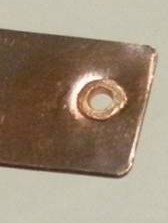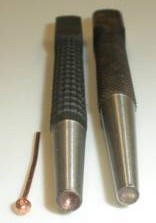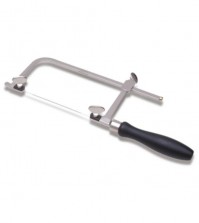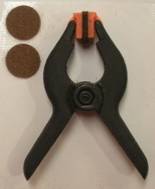- NEW DVD Series – Stone Setting with Bezels
- Tube Set Charm by Kim St. Jean
- Prong Basket Pendant by Kim St. Jean
- NEW DVD Series – Stone Setting with Cold Connections
- New DVD Series – Stone Setting with Wire
- NEW DVD Series: Introduction to Stone Setting by Kim St. Jean
- Featured Tool: Bracelet Bending Plier
- NEW Dvd by Eva Sherman
- Fun, Fast Fold Forming DVD Series
- Double Band Ear Cuff from Alex Simkin
Wire Jewelry Resource Aug. 8: Gold Filled History & Meaning
by Rose Marion, Wire-Sculpture.com
You’ve probably heard the terms “gold plated,” “gold filled,” and “rolled gold” around the wire jewelry world, and to be sure you’re telling your customers the value of the pieces you make using gold-filled wire, let’s get familiar with each of these terms. With the price of gold consistently over $1600/oz (compared with around $30/oz for silver), gold filled wire is a wonderful way for you to bring a real, beautiful golden glow to your friends’ jewelry collection, without the staggering price of a solid gold piece.
Origins of Rolled Gold and Gold Filled
In ancient times, gold wire was literally created by rolling: in Ancient Egypt, gold was hammered in to thin, thin sheets, then rolled into a tight or hollow tube, then shaped to create wire jewelry. Over time, however, this rolled gold became “filled” with a base metal, such as brass, thus gold filled with brass.
The modern gold filled wire and sheet metal technique was discovered in 1817 by John Turner, an Englishman, who patented his discovery. This form of gold roared into fashion in the decadent early Victorian Era, but there were no standards yet as to quality or thickness of the gold layer: the line between plated and the thick layer of “gold filled” was fuzzy. Victoria’s son, Edward, became king in 1901, and fashion changed to favor light, delicate, subdued jewelry in the Art Nouveau and Arts & Crafts movements. Rolled gold jewelry gave way to delicate filigree. However, gold plated pieces weren’t out of favor long: with World War I consuming resources such as the then-popular platinum, silver, and of course gold, rolled gold came back into style in the late 1930s. Now this style was called “gold filled,” and finally began to be regulated. This was the process of fusing the gold to the base metal underneath, preventing flaking.
What the Law says about Gold Filled, Rolled Gold, & Plating
In the US, the Federal Trade Commission (FTC) dictates that if the gold layer is 12kt or more, the material can only be called “gold filled” if the gold content is 1/20 of the total material, by weight. In contrast, “rolled gold” has lower gold thicknesses than gold filled, for instance 1/60 the weight of the total piece. You might see this written as 12kt RGP or 1/60 12kt RGP.
Electroplating is another gold plating technique, which regulations require to be at least 7/1,000,000-inch thick, which is still extremely thin compared to gold filled! The base metal is placed in a solution. The base metal has an electrical current through it, and the karat gold has the opposite electrical current running through it, which causes the particles to be drawn onto the base metal and coat the piece – still this plating can be as thick as a strand of human hair. Electroplating gives a thicker coat than the “gold plate” process, which typically is simply mechanically applied, usually 1/1000 to 1/1,000,000-inch thick, and is likely to wear off quickly.
If you see shorthand for metal content, such as 12/20 or 14/20, the first number refers to the karat, and the second number is how much of that karat “gold” is in the total piece. For example, Wire-Sculpture’s gold filled wire is 14/20 gold filled wire, a brass core wire sheathed in 14kt gold. The wire is 1/20 gold, and the gold layer will last for generation, not wearing or flaking like gold plate or rolled gold.
Gold and Karats
And what does karat mean again? Pure gold is called 24 karat, but pure gold is so soft, metallurgists add metals to gold to make it more durable – but these additives can also change the color of the gold. If copper is added, the gold has a yellow or red (rose) tint to it. If zinc is added, the gold becomes white. Gold can have a green tint if an alloy of zinc and silver is added!
Anything less than 24kt is an abbreviation for what has been done to enrich the gold. 12kt means that there are 12 parts pure gold by weight, and 12 parts other metals. 14kt indicates 14 parts pure gold and 10 parts other metals.
Now you know so much about ways to use gold affordably in handmade jewelry, your friends and customers will have a great new appreciation for the materials you choose to work with.
Happy jewelry making!
Sources & Further Reading
Have a piece you’re proud of, a new technique you’ve discovered, or a story you’d love to share? Submit here to be featured
Click to Receive Daily Tips by Email

























Susan
August 8, 2012 at 5:53 am
Regarding this statement present in today’s “tip of the day”: When you’re introducing a customer or a friend to their first piece of gold-filled wire, it’s important to know everything about gold-filled wire: that it won’t tarnish or flake off, and it’s the best way to incorporate real gold into any jewelry collection.
I have gold-filled wire that has turned dark orange and lost it’s luster. It is not plated. I am a certified gemologist and I understand the brass alloy causes this. It DOES tarnish over time.
Rose
August 8, 2012 at 8:28 am
Interesting, Susan, thanks for your information! All the sources I consulted indicated that it didn’t tarnish, perhaps those referred to a different “filler.” I’ve also seen pictures of gold filled jewelry from the early 1900s that still had the beautiful gold glow.
Mary Phillips
August 8, 2012 at 12:54 pm
This is such good info. Wish I knew all this years ago when I started buying gold wire. It’s a good illustration of why you should “know” your wire supplier. I’ve gotten wire from bead shows and have no idea of the real gold content. I didn’t know enough back then to ask and then tag the product when I got home.